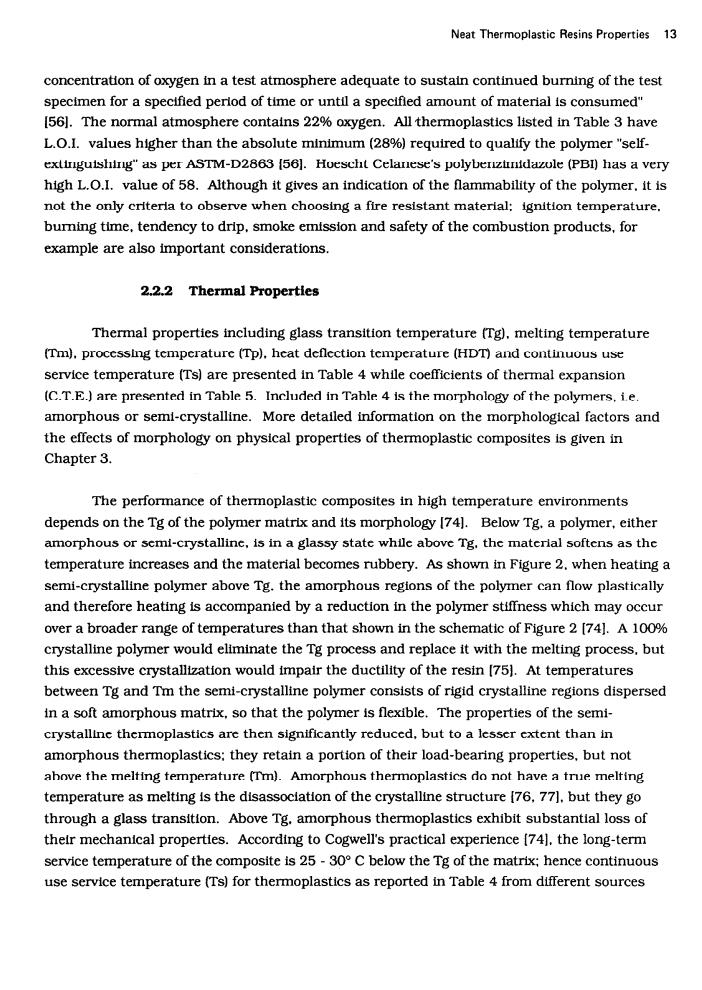正在加载图片...

Neat Thermoplastic Resins Properties 13 concentration of oxygen in a test atmosphere adequate to sustain continued burning of the test specimen for a specified period of time or until a specifled amount of material is consumed" 1561.The normal atmosphere contains 22%oxygen.All thermoplastics listed in Table 3 have L.O.I.values higher than the absolute minimum (28%)required to qualify the polymer "self- extinguishing"as per ASTM-D2863 (56].Hoescht Celauese's polyberizinidazole(PBI)has a very high L.O.I.value of 58.Although it gives an indication of the flammability of the polymer.it is not the only criteria to observe when choosing a fire resistant material:ignition temperature. burning time,tendency to drip,smoke emission and safety of the combustion products,for example are also important considerations. 2.2.2 Thermal Properties Thermal properties including glass transition temperature (Tg).melting temperature (Tm).processing temperature (Tp).heat deflection temperature (HDT)and continuous use service temperature (Ts)are presented in Table 4 while coefficients of thermal expansion (C.T.E.)are presented in Table 5.Included in Table 4 is the morphology of the polymers.i.e. amorphous or semi-crystalline.More detalled information on the morphological factors and the effects of morphology on physical properties of thermoplastic composites is given in Chapter 3. The performance of thermoplastic composites in high temperature environments depends on the Tg of the polymer matrix and its morphology [74].Below Tg.a polymer,either amorphous or scmi-crystallinc,is in a glassy state while above Tg.the material softens as the temperature increases and the material becomes rubbery.As shown in Figure 2.when heating a semi-crystalline polymer above Tg.the amorphous regions of the polymer can flow plastically and therefore heating is accompanied by a reduction in the polymer stiffness which may occur over a broader range of temperatures than that shown in the schematic of Figure 2 [741.A 100% crystalline polymer would eliminate the Tg process and replace it with the melting process.but this excessive crystallization would impair the ductility of the resin [75].At temperatures between Tg and Tm the semi-crystalline polymer consists of rigid crystalline regions dispersed in a soft amorphous matrix,so that the polymer is flexible.The properties of the semi- crystalllne thermoplastics are then significantly reduced,but to a lesser extent than in amorphous thermoplastics:they retain a portion of their load-bearing properties,but not above the melting temperature (Tm).Amorphous thermoplastics do not have a true melting temperature as melting is the disassociation of the crystalline structure [76.77].but they go through a glass transition.Above Tg.amorphous thermoplastics exhibit substantial loss of their mechanical properties.According to Cogwell's practical experience (74].the long-term service temperature of the composite is 25-30C below the Tg of the matrix;hence continuous use service temperature (Ts)for thermoplastics as reported in Table 4 from different sourcesNeat Thermoplastic Resins Properties 13 concentration of oxygen in a test atmosphere adequate to sustain continued burning of the test specimen for a specified period of time or until a specified amount of material is consumed’ 1561. The normal atmosphere contains 22% oxygen. All thermoplastics listed in Table 3 have L.O.I. values higher than the absolute minimum (28%) required to quality the polymer “selfextinguishing” as per ASTM-D2863 (561. Hoescht Celanese’s polybenzimidazole (PBI) has a very high L.O.I. value of 58. Although it gives an indication of the flammability of the polymer, it is not the only criteria to observe when choosing a fire resistant material; ignition temperature, burning time, tendency to drip, smoke emission and safety of the combustion products, for example are also important considerations. 2.2.2 Thermal Properties Thermal properties including glass transition temperature (Tg), melting temperature (Tm). processing temperature (Tp). heat deflection temperature (HDT) and continuous use service temperature (Ts) are presented in Table 4 while coefficients of thermal expansion (C.T.E.) are presented in Table 5. Included in Table 4 is the morphology of the polymers, i.e. amorphous or semi-crystalline. More detailed information on the morphological factors and the effects of morphology on physical properties of thermoplastic composites is given in Chapter 3. The performance of thermoplastic composites in high temperature environments depends on the Tg of the polymer matrix and its morphology 1741. Below Tg. a polymer, either amorphous or semi-crystalline, is in a glassy state while above Tg. the material softens as the temperature increases and the material becomes rubbery. As shown in Figure 2, when heating a semi-crystalline polymer above Tg. the amorphous regions of the polymer can flow plastically and therefore heating is accompanied by a reduction in the polymer stiffness which may occur over a broader range of temperatures than that shown in the schematic of Figure 2 [74]. A lOO?/ crystalline polymer would elhninate the Tg process and replace it with the melting process, but this excessive crystallization would impair the ductility of the resin [75]. At temperatures between Tg and Tm the semi-crystalline polymer consists of rigid crystalline regions dispersed in a soft amorphous matrix, so that the polymer is flexible. The properties of the semicrystalline thermoplastics are then significantly reduced, but to a lesser extent than in amorphous thermoplastics; they retain a portion of their load-bearing properties. but not above the melting temperature (Tm). Amorphous thermoplastics do not have a true melting temperature as melting is the disassociation of the crystalline structure (76, 771. but they go through a glass transition. Above Tg. amorphous thermoplastics exhibit substantial loss of their mechanical properties. According to Cogwell’s practical experience [74]. the long-term service temperature of the composite is 25 - 30” C below the Tg of the matrix: hence continuous use service temperature (Ts) for thermoplastics as reported in Table 4 from different sources